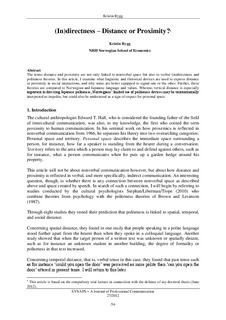| dc.contributor.author | Rygg, Kristin | |
| dc.date.accessioned | 2016-06-23T11:17:37Z | |
| dc.date.available | 2016-06-23T11:17:37Z | |
| dc.date.issued | 2012 | |
| dc.identifier.citation | SYNAPS - A Journal of Professional Communication 27(2012) | nb_NO |
| dc.identifier.issn | 1893-0506 | |
| dc.identifier.uri | http://hdl.handle.net/11250/2393870 | |
| dc.description | This article is based on the compulsory trial lecture in connection with the defense of my doctoral thesis (June 2012). | nb_NO |
| dc.description.abstract | The terms distance and proximity are not only linked to nonverbal space but also to verbal (in)directness and politeness theories. In this article, I examine what linguistic and rhetorical devices are used to express distance or proximity in social interactions, and why some are better equipped to signal one or the other. Further, these theories are compared to Norwegian and Japanese language and values. Whereas vertical distance is especially important in directing Japanese politeness, Norwegians’ limited use of politeness devices may be unintentionally interpreted as impolite, but could also be understood as a sign of respect for personal space. | nb_NO |
| dc.language.iso | eng | nb_NO |
| dc.publisher | NHH | nb_NO |
| dc.title | (In)directness – Distance or Proximity? | nb_NO |
| dc.type | Journal article | nb_NO |
| dc.source.pagenumber | 54-66 | nb_NO |
| dc.source.volume | 27 | nb_NO |
| dc.source.journal | SYNAPS - A Journal of Professional Communication | nb_NO |
